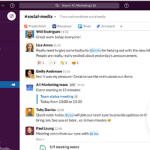The global pandemic has changed the future of work forever. An all-digital, work-from-anywhere world is the new norm. But underlying it are several socio-economic concerns. Can businesses continue to meet productivity targets and growth expectations? Will employees be happy working remotely in the long run? How can we bridge the digital divide?
To provide insights, Salesforce and the Observer Research Foundation (ORF) hosted a webinar on The Future of Work and Workspaces. The panel featured eminent business leaders, thinkers, and policy makers, including:
● Amitabh Kant, CEO, NITI Aayog
●Arundhati Bhattacharya, Chairperson and CEO, Salesforce India
● Meredith Flynn-Ripley, VP, Products, Salesforce
● Mihir Sharma, Senior Fellow, ORF
● Shrayana Bhattacharya, Senior Economist, World Bank
● Ambassador Richard Verma, Vice Chairman, The Asia Group (Moderator)
Here’s what they had to say about the future of work:
Digital transformation will take centre stage
Once merely a nice-to-have, digital transformation is now an imperative. Businesses across industries are recognising the importance of adopting digital tools, omnichannel approaches, and data-driven decision-making to succeed in today’s virtual work environments.
Digital platforms like Salesforce Anywhere can help by enabling teams to sell, service, market, and collaborate from wherever they are.
But for digitalisation to be truly successful, it has to be inclusive. Everyone must have access to affordable, high-speed internet connectivity in both urban and remote rural areas. If not, the gap between the haves and have-nots will only increase.
Workplaces will become more fluid
In a COVID-19 world, your workplace could be anywhere. Companies have realised that contrary to traditional beliefs, remote working can actually improve productivity.
Many will begin to triage their workforces based on who needs to be located in the office, and who can continue to function remotely. Some workers may never have to return to the office, while others may do so on a flexible basis depending on the nature of their work.
Those employees that do return will probably do so in collaborative pods—either with their teams to complete a specific mission, or with the colleagues they want to return with. This will give rise to new forms of employee engagement.
Employee safety and well-being will be top of mind
The key priority for companies today is to keep their workers safe and healthy—not just physically, but psychologically as well. After all, working from home can take its toll on employees’ mental health—especially when they live in cramped home spaces; or have no one to interact with; or are expected to be on call at all times of the day. These are issues that must be acknowledged and addressed.
Businesses that do reopen will need to have stringent safety and hygiene measures in place to prevent employees from being infected. Salesforce Work.com can help by bringing together trusted data to monitor employee and visitor health, streamline shift management, enable contact tracing, and more.
Building a resilient workforce will require investment
The notion of cities being the engines of growth was put to the test following the mass exodus of migrant workers during the COVID-19 lockdowns. To prevent such situations from recurring, we need to create more resilient workforces. And to do that, we must invest in building a robust social safety net for employees—one that gives them access to basic necessities such as food, insurance, unemployment benefits, and social security.
Women will also need support. Digital and work-from-home models are a huge opportunity to bring more of them back into the labour force. But that opportunity will be lost unless women are empowered with access to affordable, high quality child care and elder care. Only then can we make economic recovery and growth sustainable.
Reskilling will help workers thrive in a COVID-19 world and beyond
As more businesses shut down under the weight of the pandemic, many workers are losing their jobs. But many are also being reskilled and redeployed. For instance, gardeners are being re-trained by local municipalities to act as contact tracers for the government.
These are heartening signs because reskilling will only become more important as technologies like AI and machine learning automate existing jobs. How do we fully embrace this digital revolution while ensuring that no workers are left behind?
It starts right at the school level. We must align our education system to emphasise skills and practical learning rather than mere degrees. We must also make it easier for workers to retrain themselves and stay relevant. For instance, Salesforce’s Trailhead enables anyone to learn in-demand skills, and earn résumé-worthy credentials for the jobs of today and tomorrow.
Measures like these will be critical in creating the flexible, resilient, and adaptive workforces of the future.

























